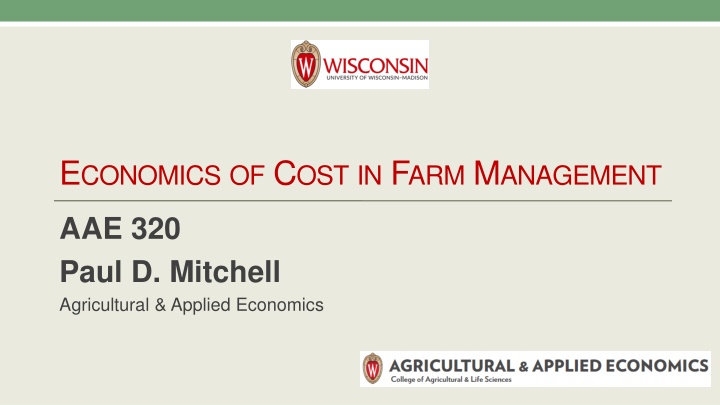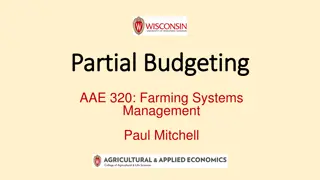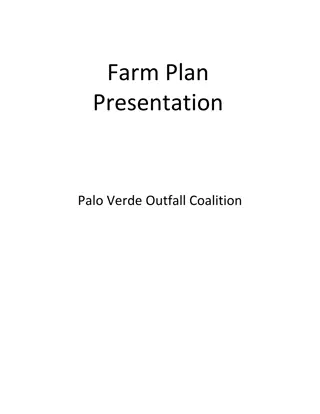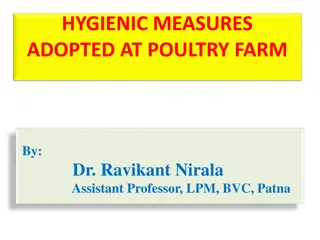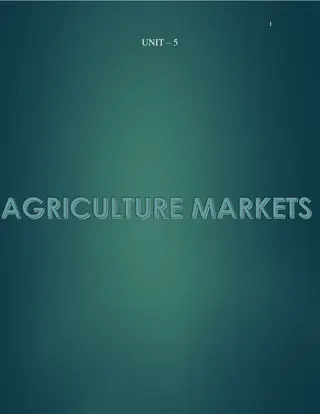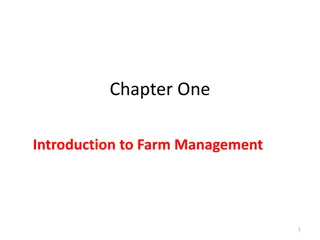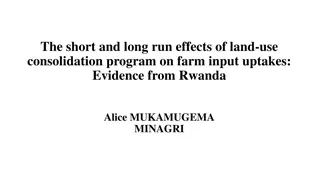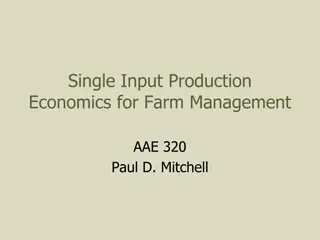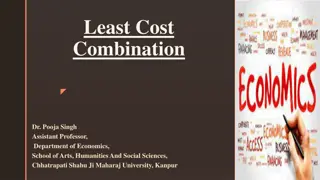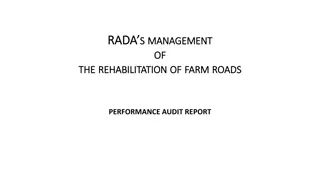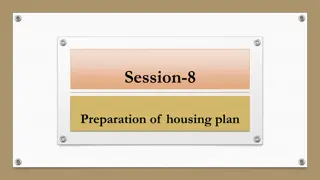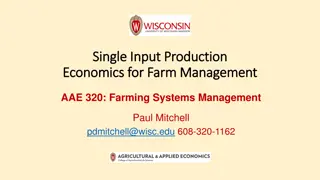ECONOMICS OF COST IN FARM MANAGEMENT
This content delves into the economics of cost in farm management, with a focus on major cost categories, financial scale of farm production, and historical data on farmer costs and prices. It explores options for farmers when faced with selling prices below their production costs, while also examining top corn and soybean producing states and projections for world grain and oilseed production.
Download Presentation

Please find below an Image/Link to download the presentation.
The content on the website is provided AS IS for your information and personal use only. It may not be sold, licensed, or shared on other websites without obtaining consent from the author.If you encounter any issues during the download, it is possible that the publisher has removed the file from their server.
You are allowed to download the files provided on this website for personal or commercial use, subject to the condition that they are used lawfully. All files are the property of their respective owners.
The content on the website is provided AS IS for your information and personal use only. It may not be sold, licensed, or shared on other websites without obtaining consent from the author.
E N D
Presentation Transcript
ECONOMICS OF COST IN FARM MANAGEMENT AAE 320 Paul D. Mitchell Agricultural & Applied Economics
Learning Goals Understand the major cost categories and the financial scale of farm production based on available cost of production budgets Focus on Midwestern corn and soybean costs Briefly look at dairy Examine historical data on farmer costs and prices Margin: average farm price minus average cost of production Explore some options for farmers when the price of what they are selling is less than their cost of production
King Corn and Queen Bean Projected world production of all grains in 2020 is 2.7 Billion metric tons Corn is 43%, Wheat is 28%, Rice is 18% of all grains produced Sorghum, Barley and Oats are the remaining 11% The US produces 1/3 of the world s corn Projected world production of oilseeds in 2020 is 609 Million metric tons Soybeans are 61% of this production The US produces 1/3 of the world s soybeans Brazil produces 36% of the world s soybeans
Top Corn and Soybean Producing States 2019 3,000 Production (million bu) 2,500 2,000 1,500 1,000 Iowa and Illinois 1st and 2nd in each crop Wisconsin 10th in corn and 14th in soybean production 500 0 600 Prodcution (million bu) 500 400 300 200 100 0
2022 2022 https://www.extension.iastate.edu/agdm/crops/html/a1-20.html
2022 2022
2022 Corn $813/ac Soybean $575/ac 13% 18% 29% 7% 40% 6% 40% 48% Machinery Labor Inputs Land Machinery Labor Inputs Land
Costs by Acres Planted (2022) Total Costs Corn $81,324 $203,309 $406,618 $609,926 $813,235 $1,219,853 $1,626,470 $1,149,920 Machinery and Inputs Corn $53,576 $133,940 $267,880 $401,820 $535,760 $803,640 $1,071,520 Land and Labor Corn $27,748 $69,369 $138,738 $208,106 $277,475 $416,213 $554,950 Acres 100 250 500 750 1,000 1,500 2,000 Soybean $57,496 $143,740 $287,480 $431,220 $574,960 $862,440 Soybean $30,556 $76,390 $152,780 $229,170 $305,560 $458,340 $611,120 Soybean $26,940 $67,350 $134,700 $202,050 $269,400 $404,100 $538,800 Corn: average of corn following corn & corn following soybeans medium yield Soybeans: medium yield case Northern IL for 2023 Corn $1160/ac, Soybeans $815/ac
Source: https://cdp.wisc.edu/category/dt/dt-financial/ $18.95/cwt x 259 cwt/cow = $4,908/cow
$18.73/cwt x 260 cwt/cow = $4,870/cow $4,698/cow https://dairy.osu.edu/newsletter/buckeye-dairy-news/volume-21-issue-1/dairy-cost-production
Costs by Herd Size (WI 2015-2017) Herd Size Cost per Cow 100 150 200 250 300 350 400 450 500 Total Cost Herd Size Cost per Cow $438,100 600 $657,150 700 $876,200 800 $1,227,250 900 $1,472,700 1,000 $1,718,150 1,250 $1,963,600 1,500 $2,209,050 1,750 $2,454,500 2,000 Total Cost $2,829,000 $3,300,500 $3,772,000 $4,243,500 $4,715,000 $5,893,750 $7,072,500 $8,251,250 $9,430,000 $4,381 $4,381 $4,381 $4,909 $4,909 $4,909 $4,909 $4,909 $4,909 $4,715 $4,715 $4,715 $4,715 $4,715 $4,715 $4,715 $4,715 $4,715
Milk Cost of Production ($/cwt) 2014-2016 Herd Size < 50 50 to 99 100 to 199 200 to 499 500 to 999 > 500 All Data AgFA (UW) $18.30 $17.62 $17.56 $17.40 $16.67 FINBIN (U of MN) $21.46 $18.58 $18.12 $18.09 $17.94 $18.36 $17.58 https://cdp.wisc.edu/wp-content/uploads/Profitability-14_15_16-C-1.pdf
WI Farm Production Expenditures in 2018 by Major Category US Farms: $358 Billion in 2019 $10 Billion in 2018, >$155,000/farm Feed 5.6% 6.1% 17.8% Farm services Labor 7.2% Supplies, repairs & construction Fertilizers & chemicals 8.8% 13.9% Machinery, vehicles & fuel Interest, taxes & misc capital 8.9% Seeds & plants 11.0% Livestock & related expenses 9.8% 11.0% Rent
Historical Prices and Costs for Iowa Corn $7 Price Cost $6 Price or Cost ($/bu) $5 $4 $3 $2 $1 $0 1975 1980 1985 1990 1995 2000 2005 2010 2015 2020 https://www.extension.iastate.edu/agdm/crops/html/a1-21.html and https://www.extension.iastate.edu/agdm/crops/html/a2-11.html
Historical Prices and Costs for Iowa Soybeans $16 Price Cost $14 $12 Price or Cost ($/bu) $10 $8 $6 $4 $2 $0 1975 1980 1985 1990 1995 2000 2005 2010 2015 2020 https://www.extension.iastate.edu/agdm/crops/html/a1-21.html and https://www.extension.iastate.edu/agdm/crops/html/a2-11.html
Historical Margins for Iowa Corn and Soybeans $4 Corn Soybean $3 Farmer Margin ($/bu) $2 $1 $0 -$1 -$2 1975 1980 1985 1990 1995 2000 2005 2010 2015 2020 https://www.extension.iastate.edu/agdm/crops/html/a1-21.html and https://www.extension.iastate.edu/agdm/crops/html/a2-11.html
Northern IL for 2023 Corn -$11/ac, Soybeans +$11/ac https://farmdocdaily.illinois.edu/2018/09/2019-crop-budgets-suggest-dismal-corn-and-soybean-returns.html
https://farmdocdaily.illinois.edu/2019/12/economic-review-of-milk-costs-in-2018-and-projections-for-the-rest-of-2019-and-2020.htmlhttps://farmdocdaily.illinois.edu/2019/12/economic-review-of-milk-costs-in-2018-and-projections-for-the-rest-of-2019-and-2020.html
Main Point Farms commonly go through periods when prices are below their cost and times when their prices are above their cost Sometimes these periods can be quite long These price & cost estimates are averages, not what every farmer gets, lots of variability exists These are the Full cost of production, including non-cash and opportunity costs for land, management and labor What does it mean to not cover all of your non-cash costs? What does it mean to not cover all of your opportunity costs? These cycles often counterbalance each other, but sometimes they coincide to create lots of farm stress and even a farm crisis Regardless: All farms will deal with times of financial stress & crisis
Why farmers need to estimate their own cost of production Cost estimates per bu or per acre are averages, not what every farm experiences Tremendous variability exists among farms and farmers Mike Duffy s Rule of Thirds Mark Stephenson s 20% Observation Gary Schnitkey Crop Production Cost and Rotation Decisions http://www.farmdoc.illinois.edu/presentations/2007%20items/ifes2007/Farm%20Economic%20Summit%20 %20Schnitkey.pdf
Farmer Tactics Know your Cost of Production Optimize variable input costs: fertilizer, herbicide, seed, Outsource activities that others can do at lower cost (partial budget analysis) Sell machinery, keep older machinery, share machinery, do custom work Use yield monitors to find unprofitable parts of fields and stop farming them Switch to crops with lower cost per acre to plant: soybean, wheat, hay or forage, so you need a smaller operating loan Negotiate lower land rents, or shift to flex leases Develop a Marketing Plan Lots of online resources, Extension, marketing clubs, hire a service Goal is to get higher prices than you would normally be getting
Farmer Tactics Accept below normal returns to survive for future profits Can you add to your off-farm income to cover family expenses? Will the bank let you eat your equity to survive? Refinance operating loan or rolling line of credit back into the farm mortgage Use yield monitors to find unprofitable parts of fields and stop farming them Need to know your cost of production UW Extension (2017): Grain Crops Management in Low-Margin Years http://ipcm.wisc.edu/blog/2017/03/videos-grain-crops-management-in-low-margin-years/ https://fyi.uwex.edu/fieldcroppathology/files/2017/01/TeamGrainsFactSheet_FINAL_2.pdf
Long-Term Reality of Farming The number of farms in the US has been declining since 1935, average farm size and herd size has been increasing Farms face continuous pressure from consolidated input suppliers and output buyers on either side of them in the supply chain Cochrane s Treadmill, technology adoption and cost efficiency [covered later] Inelasticities allow them to make money in good times (but endure low returns in bad times), but on average earn a normal return [covered later] Land & managerial ability are essential assets that allow them to make money Agriculture like many businesses values relationships: If you work with farmers, be aware of their financial ups and downs and be ready to work with them in hard times, and they will often remember you in the good times
Summary: Learning Goals Understand the major cost categories and the financial scale of farm production based on available cost of production budgets Farmers spend a lot of money, sell a lot of production Farmers go through time periods, sometimes long time periods, when prices are below their cost of production All farms will deal with times of financial stress & crisis Explored some management options for farmers when facing thin or negative margins Cost of production, optimizing inputs, partial budget analysis, marketing, farm finance
